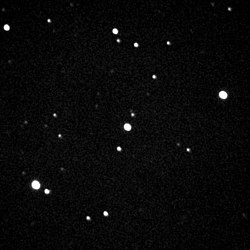astro.wikisort.org - Star
WASP-1 is a metal-rich magnitude 12 star located about 1,300 light-years away in the Andromeda constellation.[6]
| Observation data Epoch J2000 Equinox J2000 | |
|---|---|
| Constellation | Andromeda[1] |
| Right ascension | 00h 20m 40.077s[2] |
| Declination | +31° 59′ 23.79″[2] |
| Apparent magnitude (V) | 11.68 ± 0.05[3] |
| Characteristics | |
| Spectral type | F7V[4] |
| Apparent magnitude (B) | ~12.0[5] |
| Apparent magnitude (V) | 11.68 ± 0.05[3] |
| Astrometry | |
| Proper motion (μ) | RA: −4.706±0.078[2] mas/yr Dec.: −3.237±0.072[2] mas/yr |
| Parallax (π) | 2.5171 ± 0.0676 mas[2] |
| Distance | 1,300 ± 30 ly (400 ± 10 pc) |
| Absolute magnitude (MV) | 3.63+0.13 −0.14[3] |
| Details[3] | |
| Mass | 1.301+0.049 −0.047 M☉ |
| Radius | 1.515+0.052 −0.045 R☉ |
| Luminosity | 2.88+0.36 −0.30 L☉ |
| Surface gravity (log g) | 4.190+0.020 −0.022 cgs |
| Temperature | 6110±75 K |
| Metallicity [Fe/H] | 0.26±0.08 dex |
| Age | 3.0±0.6 Gyr |
| Other designations | |
| Database references | |
| SIMBAD | data |
Planetary system
In 2006, an extrasolar planet was discovered by the Wide Angle Search for Planets team using the transit method.[4] The planet has a density of 0.31 to 0.40 g/cm3, making it about half as dense as Saturn, and one third as dense as water. The orbit of WASP-1b is inclined to rotational axis of the star by 79.0+4.3
−4.5 degrees, making it a nearly "polar" orbit.[7]
Two searches for additional planets using transit-timing variations have yielded negative results.[8][9]
| Companion (in order from star) |
Mass | Semimajor axis (AU) |
Orbital period (days) |
Eccentricity | Inclination | Radius |
|---|---|---|---|---|---|---|
| b | 0.948+0.029 −0.028 MJ |
0.03958+0.00047 −0.00049 |
2.51994480±0.00000050 | <0.013 | 90.0+0.0 −2.9° |
1.514+0.052 −0.047 RJ |
See also
- SuperWASP
- List of extrasolar planets
References
- Roman, Nancy G. (1987). "Identification of a Constellation From a Position". Publications of the Astronomical Society of the Pacific. 99 (617): 695–699. Bibcode:1987PASP...99..695R. doi:10.1086/132034. Vizier query form
- Brown, A. G. A.; et al. (Gaia collaboration) (August 2018). "Gaia Data Release 2: Summary of the contents and survey properties". Astronomy & Astrophysics. 616. A1. arXiv:1804.09365. Bibcode:2018A&A...616A...1G. doi:10.1051/0004-6361/201833051. Gaia DR2 record for this source at VizieR.
- Torres, Guillermo; Winn, Joshua N.; Holman, Matthew J. (2008). "Improved Parameters for Extrasolar Transiting Planets". The Astrophysical Journal. 677 (2): 1324–1342. arXiv:0801.1841. Bibcode:2008ApJ...677.1324T. doi:10.1086/529429. S2CID 12899134.
- Cameron, A. Collier; et al. (2007). "WASP-1b and WASP-2b: two new transiting exoplanets detected with SuperWASP and SOPHIE". Monthly Notices of the Royal Astronomical Society. 375 (3): 951–957. arXiv:astro-ph/0609688. Bibcode:2007MNRAS.375..951C. doi:10.1111/j.1365-2966.2006.11350.x. S2CID 735515.
- "TYC 2265-107-1". SIMBAD. Centre de données astronomiques de Strasbourg. Retrieved 2009-05-20.
- Stempels, H. C.; et al. (2007). "WASP-1: a lithium- and metal-rich star with an oversized planet". Monthly Notices of the Royal Astronomical Society. 379 (2): 773–778. arXiv:0705.1677. Bibcode:2007MNRAS.379..773S. doi:10.1111/j.1365-2966.2007.11976.x. S2CID 17565024.
- Simpson, E. K.; Pollacco, D.; Cameron, A. Collier; Hébrard, G.; Anderson, D. R.; Barros, S. C. C.; Boisse, I.; Bouchy, F.; Faedi, F.; Gillon, M.; Hebb, L.; Keenan, F. P.; Miller, G. R. M.; Moutou, C.; Queloz, D.; Skillen, I.; Sorensen, P.; Stempels, H. C.; Triaud, A.; Watson, C. A.; Wilson, P. A. (2011). "The spin-orbit angles of the transiting exoplanets WASP-1b, WASP-24b, WASP-38b and HAT-P-8b from Rossiter-Mc Laughlin observations★". Monthly Notices of the Royal Astronomical Society. 414 (4): 3023–3035. arXiv:1011.5664. Bibcode:2011MNRAS.414.3023S. doi:10.1111/j.1365-2966.2011.18603.x. S2CID 46522188.
- Granata, V.; et al. (2014). "TASTE IV: Refining ephemeris and orbital parameters for HAT-P-20b and WASP-1b". Astronomische Nachrichten. 335 (8): 797–803. arXiv:1405.3288. Bibcode:2014AN....335..797G. doi:10.1002/asna.201412072. S2CID 118341059.
- Maciejewski, G.; et al. (2014). "Revisiting Parameters for the WASP-1 Planetary System" (PDF). Acta Astronomica. 64 (1): 11–26. arXiv:1402.6518. Bibcode:2014AcA....64...27M.
- Bonomo, A. S.; et al. (2017). "The GAPS Programme with HARPS-N at TNG . XIV. Investigating giant planet migration history via improved eccentricity and mass determination for 231 transiting planets". Astronomy and Astrophysics. 602. A107. arXiv:1704.00373. Bibcode:2017A&A...602A.107B. doi:10.1051/0004-6361/201629882. S2CID 118923163.
External links
- "Planet WASP-1 b". The Extrasolar Planets Encyclopaedia. Retrieved 2018-11-07.
- Image WASP 1
На других языках
[de] WASP-1
WASP-1 ist ein Stern im Sternbild Andromeda. Der Stern wird von einem Transitplaneten mit der Bezeichnung WASP-1 b begleitet.- [en] WASP-1
[es] WASP-1
WASP-1 es una estrella perteneciente a la Constelación de Andrómeda. La ronda un planeta extrasolar, llamado WASP-1b.[ru] WASP-1
WASP-1 — звезда в созвездии Андромеда, находящаяся за 1030 световых лет от нас. Это жёлто-белый карлик класса F главной последовательности. По размерам и массе она чуть больше нашего Солнца. У звезды имеется планетная система.Текст в блоке "Читать" взят с сайта "Википедия" и доступен по лицензии Creative Commons Attribution-ShareAlike; в отдельных случаях могут действовать дополнительные условия.
Другой контент может иметь иную лицензию. Перед использованием материалов сайта WikiSort.org внимательно изучите правила лицензирования конкретных элементов наполнения сайта.
Другой контент может иметь иную лицензию. Перед использованием материалов сайта WikiSort.org внимательно изучите правила лицензирования конкретных элементов наполнения сайта.
2019-2025
WikiSort.org - проект по пересортировке и дополнению контента Википедии
WikiSort.org - проект по пересортировке и дополнению контента Википедии
